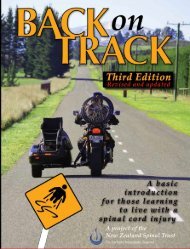o_19m515s4j1asl13rsiok91e166nh.pdf
You also want an ePaper? Increase the reach of your titles
YUMPU automatically turns print PDFs into web optimized ePapers that Google loves.
Messages & Signals<br />
Sensory Messages<br />
Sensory messages are sent from parts of your<br />
body, i.e. your hand, to your spinal cord.<br />
The spinal cord then relays the message to<br />
the brain. When the message reaches your<br />
brain it is interpreted as a feeling such as<br />
touch, pressure, pain or temperature (hot<br />
or cold). There is another vital sensation<br />
that you may never have been aware of. It<br />
is called proprioception and it subconsciously<br />
keeps track of what position your limbs and<br />
joints are in. Proprioception messages give<br />
the brain information about body position to<br />
help the brain coordinate precise movements<br />
almost unconsciously i.e. that it is time to<br />
move your hand to another position.<br />
1. Pain message sent off<br />
from foot<br />
2. Reflex reactio<br />
bounces off spin<br />
3. Brain checks to see if<br />
danger is cleared and<br />
then limits movement<br />
Motor Messages<br />
Motor messages begin in your brain and<br />
travel down your spinal cord. Spinal nerves<br />
direct these messages to the appropriate<br />
parts of your body. These signals control<br />
most of the muscles in your body.<br />
Reflex Messages<br />
Your body has an amazing defence<br />
mechanism built into it. Not all messages<br />
sent from parts of your body go all the way<br />
to the brain. The spinal cord has the ability<br />
to make some decisions on its own.<br />
For example, if you stepped on a sharp tack,<br />
your skin sends a sensory message to the<br />
spinal cord. If the message is identified as a<br />
‘panic’ signal then the spinal cord will send<br />
a reflex signal to the muscle group where<br />
the message originated. Your foot will jerk<br />
away from the source of pain immediately<br />
without you having to think about it i.e. it<br />
happens automatically.<br />
The original message will still get to the<br />
brain and your brain will limit the reflex<br />
reaction.<br />
© New Zealand Spinal Trust, 2014<br />
25
















